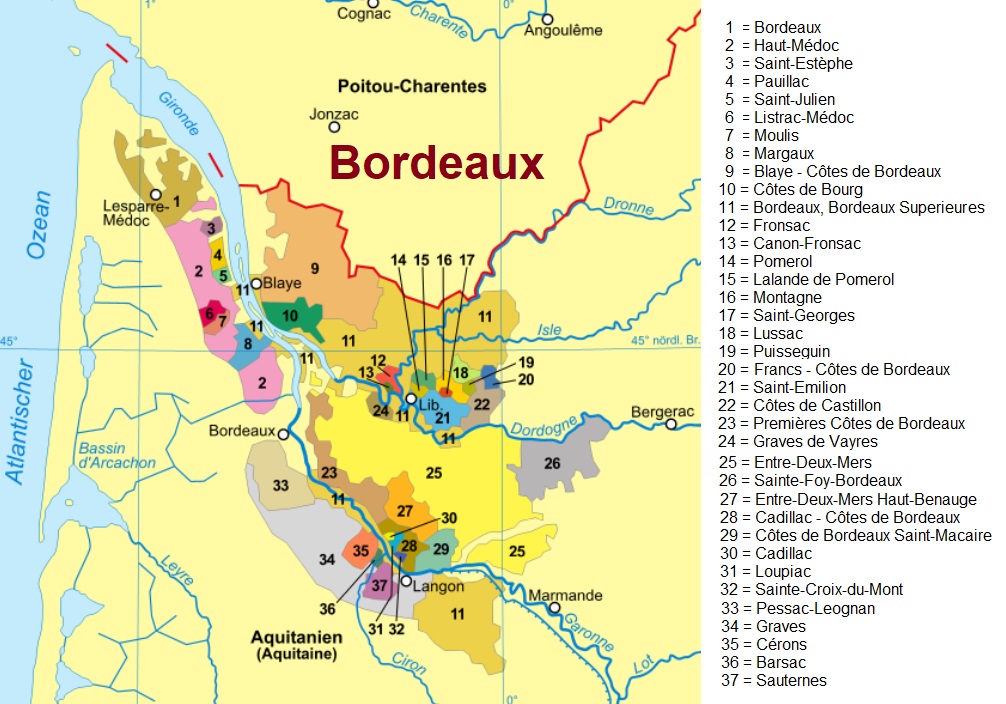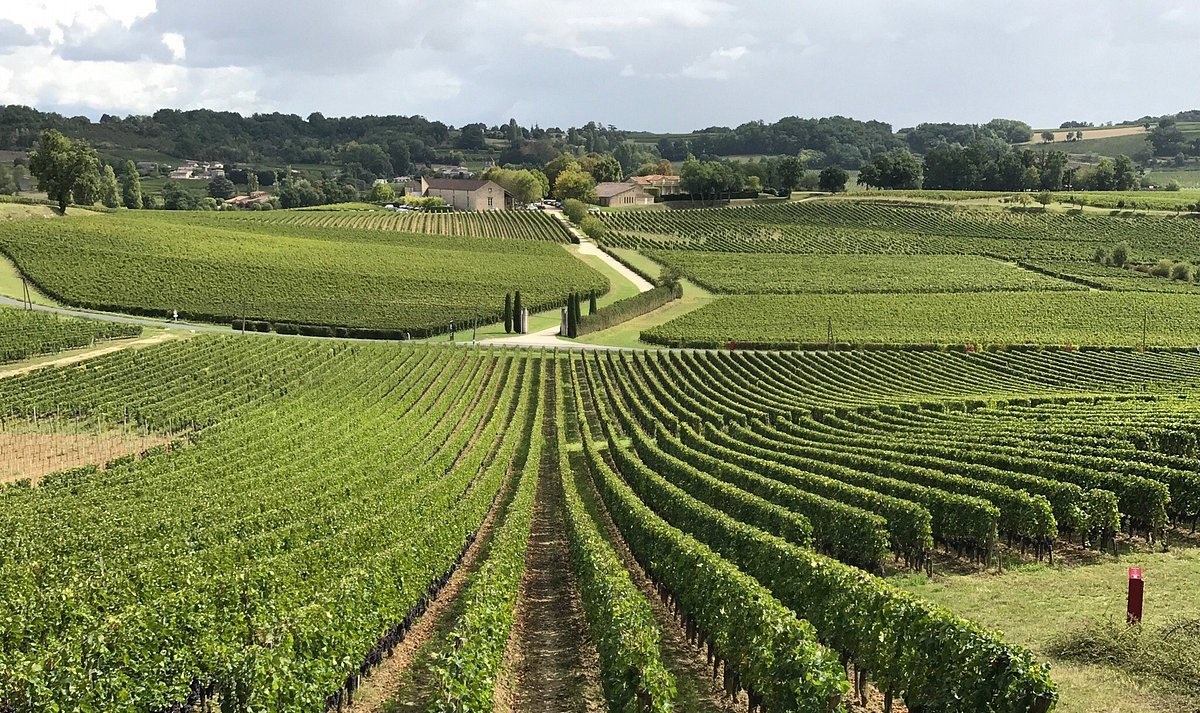Results
2,284 Results
Loading more Results ...
Loading more Results ...
| Saint-Emillion AOC |
Description to Saint-Emillion AOC
The French wine-growing area is located in the east of the Bordeaux region and, together with Pomerol, forms the core area of the Rive droite (right bank) of the Gironde and Dordogne estuaries. It is named after the small town of around 2,000 inhabitants, which lies on the slopes of a hill overlooking the Dordogne valley and is named after the holy Benedictine monk Émilion (Aemilianus). According to legend, he lived here in the 7th century in the forest of Combes in a cave, which is now located on the grounds of Château Laniote. Saint-Émilion is also a stop on the Way of St James to Santiago de Compostela. It is one of the oldest wine-growing regions in France, as the Romans planted the first vines here.

Soil, climate and grape varieties
In 1999, Saint-Émilion was the first wine-growing area in the world to be declared a UNESCO World Heritage Site. In addition to Saint-Émilion, the ten by five kilometre area includes the municipalities of Saint-Christophe-des-Bardes, Saint-Hippolyte, Saint-Étienne-de-Lisse, Saint-Laurent-des-Combes, Saint-Pey-d'Armens, Saint-Sulpice-de-Faleyrens, Vignonet and partly Libourne. The four communes of Lussac, Montagne, Puisseguin and Saint-Georges, separated by the small Barbanne watercourse, are independent appellations that are allowed to display the place name with the addition Saint-Émilion on the label.

The climate is more continental and not as maritime as in the Médoc to the west, with greater temperature fluctuations. The vineyards lie between 25 and 100 metres above sea level. The region is characterised by a variety of soil types, often even within the individual châteaux. They are roughly divided into four zones: Plateau (limestone formations with clay-limestone or sandy clay), Côtes (similar, but different slope inclination and orientation), Graves (gravel and coarse gravel) and Sables (alluvial gravel). These soils also produce different types of wine.
The vineyards cover around 5,500 hectares of vines, which are cultivated by over 1,000 winegrowers. Red wines are produced for the most part, and only these have appellation status. The full-bodied, full-bodied wines with a silky texture are produced from the dominant Merlot variety, which covers around 60% of the vineyard area here, as well as Cabernet Franc (here Bouchet) with proportions of Cabernet Sauvignon, Cot (here Malbec, Pressac) and Carmenère (also Carbouet); the typical grape varieties of the Rive droite. Long maceration periods and barrique ageing in mostly new French oak barrels are common. They are softer, fruitier and less tannic than those from the Médoc.
Saint-Émilion Grand Cru Classé classification
In contrast to the unique Bordeaux classification of 1855 (only wines from the left bank of the Garonne), it is revised every ten years. The criteria have been constantly adapted since its introduction, but some basic values have always been part of the assessment. These are the quality of the last ten vintages, the reputation of the wine, the market price achieved and the quality of the terroir and the methods of vineyard management. In 2022, aspects of sustainable management and social media presence were added. Wineries wishing to take part in an assessment can apply either for the "Grand Cru Classé" or for the two levels "Grand Cru Classé" and "Premier Grand Cru Classé".
The classification applies exclusively to the winery's Grand Vin (first wine) and is only valid for a defined part of the vineyards. All other wines, such as second wines or white wines, must have a different designation from the first wine as the main name on the label. In rare cases, a winery may have two first wines, each with a different name (for example Château Faugères). Compared to the simple AOC Saint-Émilion, the requirements are stricter. The yield is limited to a maximum of 8,000 kg/ha or 55 hl/ha (instead of 9,000 kg/ha or 65 hl/ha). The must weight of the grapes (except Merlot) must be at least 189 g/l sugar (instead of 180 g/l). The alcohol content must be at least 11.5% (instead of 11%) by volume. The wine must be stored for at least 14 months before being marketed.
The wine is assessed by a jury of experienced wine tasters using a blind tasting with a 20-point system. At least 14 points are required for the Grand Cru Classé and at least 16 points for the Premier Grand Cru Classé. Every wine with 16 points or more is proposed for the "Premier Grand Cru Classé" classification. The total number of classified wineries is limited to a maximum of 90. Wines that are no longer classified or classified differently retain their classification for the previous vintages. Classifications have so far been awarded in 1955 (75 wines), 1969 (84 wines), 1986 (74 wines), 1996 (68 wines), 2006 (61 wines), 2012 (82 wines) and 2022 (85 wines). There are the following three quality levels:
- Grand Cru Classé
- Premier Grand Cru Classé B
- Premier Grand Cru Classé A (equivalent in quality to the Premier Cru Classé Châteaux of the Médoc)
Classification 2006
After the 2006 classification, there were protests from downgraded wine estates. The four declassified Château Cadet-Bon, Château Guadet, Château La Marzelle and Château La Tour-du-Pin-Figeac lodged a protest or a challenge to the result with the administrative court in Bordeaux (apart from Château La Tour-du-Pin-Figeac, the other three were reclassified in 2012). After examination, the court found that it was grossly incorrect to first taste the wines of already classified estates and then the others separately. As a result, there was a confusing back and forth.
First, the 2006 classification was overruled and the 1996 classification was put into effect, then this was rejected again and the 2006 upgrade of eight châteaux was confirmed, then this was rejected again and finally a "final" decision was made on 13 May 2009. The 1996 classification was now valid again. However, it was noted in a footnote that the eight châteaux upgraded in 2006 (6 Grand Cru Classé and 2 Premier Grand Cru Classé B) may retain their new rank.
Classification 2012
The classification was carried out under the supervision of the INAO by a jury of seven professional tasters. To ensure independence, no members of the Saint-Émilion Syndicat or the Bordeaux wine trade were among them, but experts from the Burgundy, Champagne, Loire, Provence and Rhône regions. A total of 82 wine estates (18 Premiers Grands Crus and 64 Grands Crus) were classified. 2 new wineries received the highest honour, 4 new wineries received the Premier Grand Cru Classés B award and 9 new Grand Cru wineries.
In 2013, the classification was invalidated several times due to errors and breaches of the regulations. There were complaints from some wine estates because Hubert de Boüard (the owner of Château Angélus) was the chairman of the classification commission and was therefore, in their opinion, biased. Boüard was sentenced to a fine.
Classification 2022
A total of 144 wineries took part in the application. The result was published by the INAO on 8 September 2022 with 85 classified wineries (14 Premiers Grands Crus and 71 Grands Crus). The wine estates Château Angélus, Château Ausone, Château Cheval Blanc and Château La Clotte announced that they would not be applying this time. They criticised the fact that the aspects of tourism and social networks were given too much space in the evaluation and that "primary" aspects such as terroir, wine ratings, wine quality and cultivation were given too little consideration. As a result, three wineries in the highest level Premier Grand Cru Classé A from 2012 voluntarily left the classification.
No application was submitted for Château Quinault l'Enclos either and Château Croque-Michotte and Château La Gaffelière withdrew early. The wine estates Château Croix de Labrie, Château Tour Saint-Christophe and Château Rocheyron protested against not being considered. The first two were successful in their appeal before the Bordeaux Administrative Court, while the appeal of the latter estate was not upheld.
Premier Grand Cru Classé A (2)
- Château Figeac (new from 2022)
- Château Pavie
Premier Grand Cru Classé B (12)
- Château Beauséjour Duffau-Lagarosse
- Château Beau-Séjour-Bécot
- Château Bélair-Monange
- Château Canon
- Château Canon-La-Gaffelière
- Château Larcis-Ducasse
- Château Pavie-Macquin
- Château Troplong-Mondot
- Château Trotte Vieille
- Château Valandraud
- Clos Fourtet
- La Mondotte
Grand Cru Classé (71)
- Château Badette (new since 2022)
- Château Balestard La Tonnelle
- Château Barde-Haut
- Château Bellefont-Belcier
- Château Bellevue
- Château Berliquet
- Château Boutisse (new since 2022)
- Château Cadet-Bon
- Château Cap-de-Mourlin
- Château Chauvin
- Château Clos de Sarpe
- Château Clos des Jacobins
- Château Corbin
- Château Corbin-Michotte
- Château Côte de Baleau
- Château Couvent des Jacobins
- Château Croix de Labrie (new since 2022)
- Château Dassault
- Château de Ferrand
- Château de Pressac
- Château Destieux
- Château Faugères
- Château Fleur-Cardinale
- Château Fombrauge
- Château Fonplégade
- Château Fonroque
- Château Franc-Mayne
- Château Grand Corbin
- Château Grand Corbin-Despagne
- Château Grand-Mayne
- Château Guadet
- Château Haut-Sarpe
- Château Jean Faure
- Château La Commanderie
- Château La Confession
- Château La Couspaude
- Château La Croizille
- Château La Dominique
- Château La Fleur Morange
- Château La Marzelle
- Château Laniote
- Château Larmande
- Château Laroque
- Château Laroze
- Château La Serre
- Château La Tour Figeac
- Château Le Chatelet
- Château Le Prieuré
- Château Mangot
- Château Monbousquet
- Château Montlabert (new since 2022)
- Château Montlisse (new since 2022)
- Château Moulin du Cadet
- Château Péby Faugères
- Château Petit-Faurie-de-Soutard
- Château Ripeau
- Château Rochebelle
- Château Rol Valentin (new since 2022)
- Château Saint-Georges-Côte-Pavie
- Château Sansonnet
- Château Soutard
- Château Tour Baladoz (new since 2022)
- Château Tour Saint-Christophe (new since 2022)
- Château Villemaurine
- Château Yon-Figeac
- Clos Badon Thunevin (new since 2022)
- Clos de L'Oratoire
- Clos Dubreuil (new since 2022)
- Clos Saint-Julien (new since 2022)
- Clos Saint-Martin
- Lassegue (new since 2022)
Further information
In France, there is a bewildering variety of classification systems for wines, wineries and appellations. This is even the case within a single region, particularly in Bordeaux. In addition to Saint-Émilion, there are those of Graves, Médoc and Sauternes. There is a consistent system in Burgundy. See also under Grand Cru and quality system.
Map: by Domenico-de-ga from Wikipedia, CC BY-SA 3.0, Link
Vineyards: Tripadvisor
Text source 2022: WIKIPEDIA Saint-Émilion
Recent wines 6
 Clos Fourtet
— Bordeaux
2012 Saint-Emillion AOC Premier Grand Cru Classé
90 WP
excellent
Clos Fourtet
— Bordeaux
2012 Saint-Emillion AOC Premier Grand Cru Classé
90 WP
excellent

 Les Grands Chateaux de Naujan
— Bordeaux
2014 Saint-Emillion AOC Isabeau de Naujan
88 WP
very good
Les Grands Chateaux de Naujan
— Bordeaux
2014 Saint-Emillion AOC Isabeau de Naujan
88 WP
very good

 Château Croix de Bertinat
— Bordeaux
2012 Saint-Emillion AOC
86 WP
very good
Château Croix de Bertinat
— Bordeaux
2012 Saint-Emillion AOC
86 WP
very good

The most important grape varieties
More information in the magazine
- Good Bordeaux doesn't have to be expensive! Crus Bourgeois
- Liv-ex Power 100: Bordeaux The number of brands in the top 100 has fallen to a new low
- Château Léoville Barton Saint Julien, 1997 Bordeaux, France
- Château Latour à Pomerol Latour à Pomerol 1981, Pomerol, Bordeaux, France
- Château Pichon Longueville Baron Les Tourelles de Longueville 1996, Pauillac, Bordeaux, France
- Château Beychevelle Beychevelle 2000, Saint Julien, Bordeaux, France
- Châteaux Ausone Ausone 1997, Saint-Emilion Grand Cru, Bordeaux
- Château Léoville Poyferré Saint Julien, 1997, Bordeaux
- Château de Monbousquet Angélique de Monbousquet 2008, Saint Emilion, Bordeaux
- Château Laujac Laujac 1996, Cru Bourgeois, Médoc, Bordeaux, France